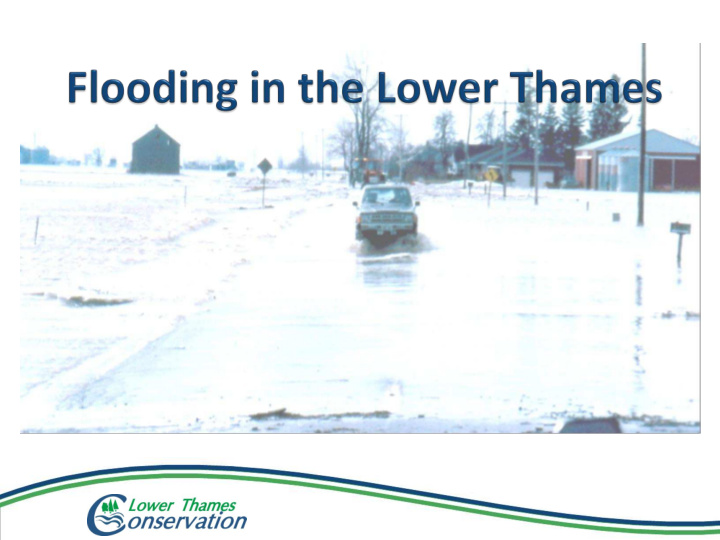



The Thames River is the primary focus of flooding but some areas are prone to Great Lakes Flooding as well.
Maintain a watershed monitoring network in order to assist in the issuance of flood messages to the Municipalities and other selected agencies. Provide other technical advice of flood related matters to the Municipalities and other selected agencies.
Undertake certain designated emergency measures to alleviate flooding beyond the means of a single Municipality. Liaise between the Municipalities and the Province on matters relating to the procurement of provincial assistance during a flood emergency.
Has experienced a long history of flooding The most probable flood event is one that originates from rain and snowmelt. Severe floods have The resulting flooding occurred in 1937, 1947, can be aggravated in 1948, 1968, 1977, 1979 some areas due to ice and 1985. jamming.
5825 km 2 2nd largest watershed in Ontario 3482 km 2 in the UTRCA 3275 km 2 in the LTVCA
Dams Fanshawe Wildwood Pittock Mitchell R. T. Orr
Flooding caused by rainfall in the watershed of the Lower Thames During the same first day of runoff, the smaller creeks and drains will enter the lower Thames River Need extreme rainfall event(s) (multiple days with rain) or heavy rains on top of already saturated soil conditions such as those typical in the spring Consecutive flooding on the tributaries of the Thames River such as McGregor Creek
Caused by heavy rainfall in the Upper Thames watershed Causes high flows in the Upper Thames that then pass downstream Can back up local tributaries causing further flooding
On the first day, flows converge at the forks of the Thames River in London. While in the lower Thames, flows from the tributaries enter somewhat in parallel.
Thames Street in Chatham The 1939 flood event became the Regulation event for Floodplain Management in the Thames River basin.
Water passing over Grande River Line in Dover Twp. Estimated 170 m 3 /s passed over Grande River Line, an equal amount passed over Riverview Line, and 450 m 3 /s passed the ice jam.
Looking south towards the Thames River. Thamesville has no flood control infrastructure against flooding and back up flooding from the Thames River.
Runoff flooding on Indian and McGregor Creeks is caused by heavy rainfall (and sometimes snowmelt) on the watersheds. Backup flooding from the Thames River occurs when the water from upriver finally makes its way to Chatham and backs up that same system into the low lying South Chatham area.
Queen St. and Indian Creek Road ◦ looking west along the Indian Creek watershed ◦ February 25 th , 1985 flood
From 5 th St. Bridge ◦ Typical spring flooding ◦ April 14 th , 2013
230 km 2 drainage area. Combined watershed of Indian Creek, McGregor Creek and the Wolfe Drain makes up approximately 10% of Chatham-Kent.
Composed of a Diversion Channel and Dam, and a Backwater Dam and Pumping Station at the outlet of McGregor's Creek into the Thames River. Environmental Assessment process began in 1984. Construction from 1989 to 1992. Total project cost $16.5 million dollars. Estimated $30 million worth of flood prevention benefits to over 2,000 homes and businesses. A typical operation of just the Diversion in 2013 was estimated to have prevented $340,000 in damage.
Channel is 3.3 kilometres long, 6 metres deep with a top width of 50 metres. The Diversion Channel, with associated dams and bridges, was constructed over a two and one half year period starting in 1989 and cost approximately 11 million dollars.
Dam has 4 gates each measuring 5 x 3 m. Closed only when water in the Thames River is high. Pumping is required when the dam is closed in order to drain water from flows coming down through the McGregor and Indian Creek watersheds. Has a pumping capacity of 8.5 cubic metres per second. Dam and Pumping Station were constructed in 1991 at a cost of $3 million.
But when they do overtop, or breach, flooding can spread a fair distance from the Thames River, impacting several thousand rural residences and agricultural lands.
1979 – 9,000 Acres, 100 Homes 1981 – 4,500 Acres, 200 Homes 1984 – 2,000 Acres, 200 Homes 1985 – 14,000 Acres, 380 Homes
Recommend
More recommend